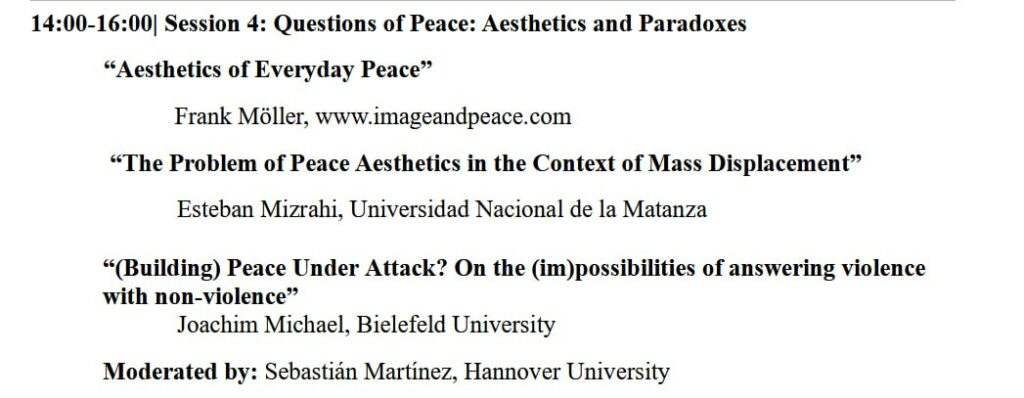People on the Move is one of the most pressing and one of the most visualized issues of our time. While human mobility has been the subject of a huge amount of academic research, we still do not know enough about the main questions that the conference Pragmatics of Peace on the Move: Challenging Perspectives on Mobility-related Conflictivity at Bielefeld University’s prestigious Center for Interdisciplinary Research (ZIF) addressed: how do “the peace perspectives held by individuals” relate to “forced mobility” and in what ways are these perspectives enacted?
Even in adverse circumstances, the conference organizers argue, “various forms of individual or group agency remain possible,” some of which can be described, in terms suggested by Roger Mac Ginty, as everyday peace.¹
Reflecting an interest on the part of the organizers in the role “art [can] play in fostering peace,” they invited Frank to present imageandpeace’s point of view in a presentation titled “Aesthetics of Everyday Peace.”

After briefly clarifying Mac Ginty’s position, we suggested decoupling the concept of everyday peace from deeply divided societies, arguing that it may equally well be applied to all forms of peace during war and organized violence, especially to the continuation of mundane, everyday activities (coping mechanisms) in adverse and often dangerous conditions as deliberate actions, showing own agency.
Everyday peace, in this understanding, refers to “individual and collective microsteps indicating resistance, resilience and a profound will to survive, defying the logic [and the dynamics] of violence” and maintaining human dignity.”² Such microsteps can be visualized; indeed, they have to be visualized because “what we see determines to some extent what we think of as possible.”³ What we do not see does not exist.
After elaborating this understanding of everyday peace with reference to the sieges of Leningrad and Sarajevo and the continuation of everyday, in particular cultural activities, during these sieges, the presentation suggested further reflections on selected questions pertaining to everyday peace:
Is everyday peace everyday peace – in other words, is peace the best concept with which to grasp mundane activities in a time of war and violence?
Do we trivialize the concept of peace by applying it to mundane activities which, in all likelihood, will not change the overall conditions directly and immediately?
How far can the concept of everyday peace be stretched without losing plausibility?
Does everyday peace support the perception of war as normal?⁴
How do we differentiate the perpetrators’ everyday peace from the victims’ everyday peace? Images do not always make this differentiation for us.
How do technological developments, for example everyday drones, challenge the theories and practices of everyday peace?
We would like to thank the organizers for the invitation and the possibility to share some thoughts on everyday peace and its visualization with the participants in this stimulating and thought-provoking meeting.
References
¹ Roger MacGinty, “Everyday peace: Bottom-up and local agency in conflict-affected societies,” Security Dialogue, 2014, Vol. 45(6), pp. 548–564
² Rasmus Bellmer and Frank Möller, Peace, Complexity, Visuality: Ambiguities in Peace and Conflict (Houndmills: Palgrave Macmillan, 2023), p. 93
³ Rasmus Bellmer, Tiffany Fairey and Frank Möller, “Peace Photography, Visual Peacebuilding and Participatory Peace Photography,” in The Routledge Handbook of Conflict and Peacebuilding Communication, edited by Stacey Connaughton and Stefanie Pukallus (New York: Routledge, 2025), p. 343
⁴ See https://www.theguardian.com/world/article/2024/jul/28/western-djs-accused-normalising-war-playing-russian-techno-events-outline-festival
Pragmatics of Peace on the Move: Challenging Perspectives on Mobility-related Conflictivity, ZIF (Center for Interdisciplinary Research), University of Bielefeld, 15–17 January 2025
